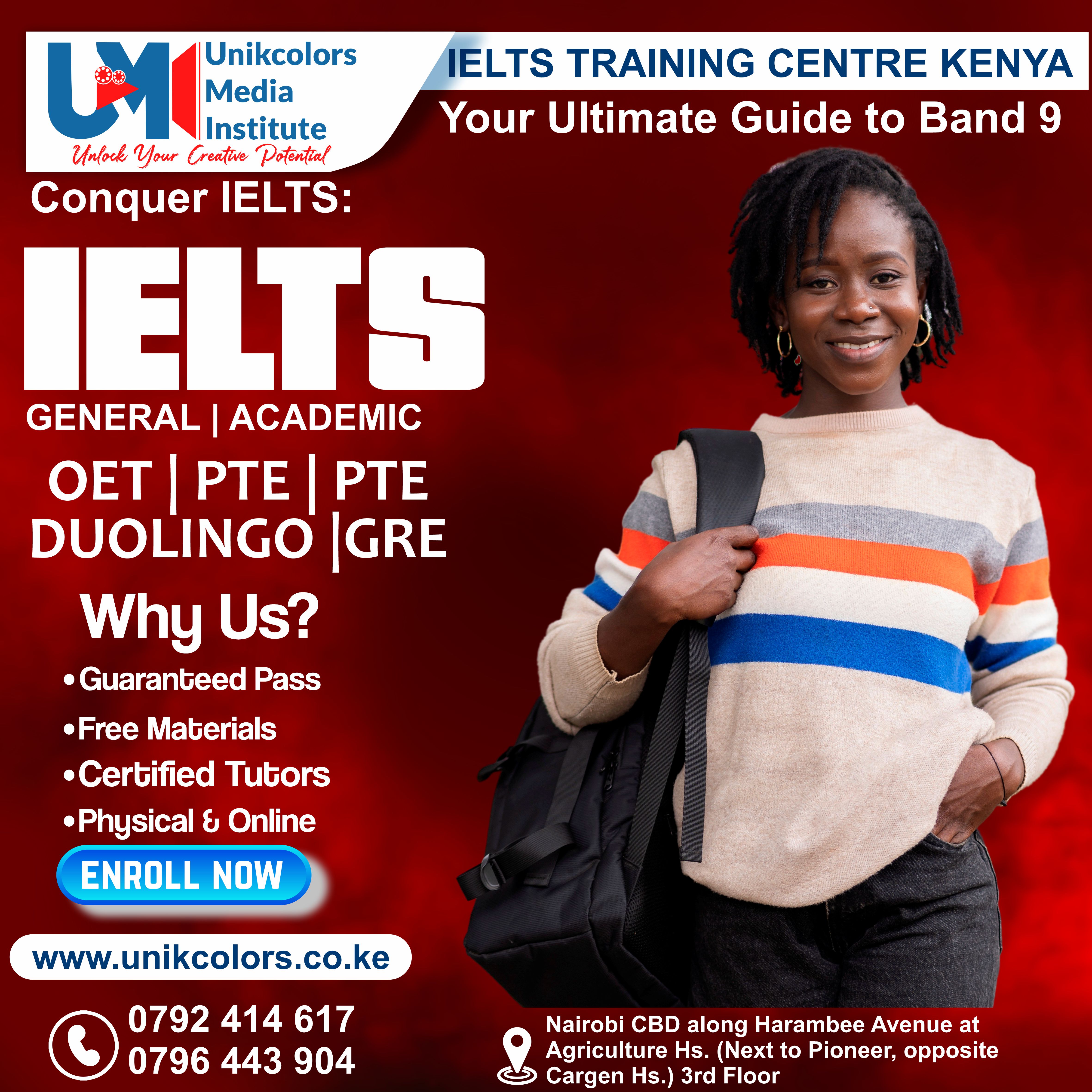IELTS TRAINING CENTRE KENYA - IELTS PREPARATION | OET | TOEFL | PTE | GRE | DUOLINGO

Title: IELTS TRAINING CENTRE KENYA - IELTS PREPARATION | OET | TOEFL | PTE | GRE | DUOLINGO
How to manage your time in IELTS Reading
How much time do I get for IELTS Reading?
You have 60 minutes to answer 40 questions. That’s 90 seconds per question. Why is it then that so many people have trouble managing their time in IELTS Reading and how can you manage your time effectively?
That’s what we’re going to answer in this blog.
Before I show you how to manage your time effectively in IELTS reading, let me give you a quick overview of the challenge you’re facing.
IELTS Reading Overview
How fast do I need to read the IELTS Reading section?
In your reading test, you will get three reading passages. The 40 questions will be based on these three passages. So you’ll complete about 13 or 14 questions per passage.
The total word count of all three passages is important because it allows us to calculate the speed at which you need to read. According to the IELTS official, the three passages have a total of about 2,500 words and then there’s about 500 words in the questions, so about 3,000 words in total.
To read 3,000 words in 60 minutes means that you need to read at an average speed of 50 words per minute. That is not fast. That’s, in fact, very slow. Let’s put it into perspective.
The average native-English speaker read at an average rate of 250 words per minute – by analogy, that’s the equivalent of driving at 100km per hour.
So if you only have to read at only 50 words per minute. Well, that’s the equivalent of driving at about 20km per hour.
So what’s the problem then? Because it seems that you have more than enough time to read. If I read the three passages at 250 words per minute, an average speed, then I could read from top to bottom, including the questions in just 12 minutes. So why do so many people struggle with time management in IELTS reading?
There are a few critical things we need to iron out because it’s not necessarily how fast you read, it’s not just about speed or pace; it’s actually more about how you read and what you do with your mind (and eyes) on test day.
But before we look at critical strategies to improve your reading speed and accuracy, let’s firstly understand the reading test a little bit more deeply so we know what we’re dealing with.
IELTS Reading General vs Academic
The first thing you need to know is that there is a difference between the IELTS General and IELTS Academic reading tests in terms of the texts types.
If you’re taking IELTS General you’ll have to read texts similar to:
- Newspapers
- Advertisements
- Handbooks
- Notices
If you’re taking IELTS Academic, you’ll have to read texts similar to:
- Newspapers
- Books
- Journals
- Magazines
The academic test will use language that is a little more complex in terms of its vocabulary and sentence structure; but that’s the only real difference between the two test types. Apart from that, everything else is the same.
Both tests have eleven different question types. You might not get all eleven types on test day, but you’ll get a variety. There’s
- Multiple choice
- True / False / Not Given (facts)
- Yes / No / Not Given (opinions)
- Matching information
- Matching headings
- Matching features
- Matching sentence endings
- Sentence completion
- Summary, note, table, flow-chart completion
- Diagram label completion
- Short-answer questions
Reading Types
Okay, now that we know what we’re dealing with, let’s take a closer look at how to maximise our reading efficiency and accuracy, and to do that we need to discuss:
There are actually three ways of reading or three types of reading that you need to do on test day:
- Speed reading
- Search reading
- Careful reading
Let’s understand:
1. Speed Reading
The first thing you should do when you sit down and open your test paper is a very quick ‘speed read’ of the passage. You should speed read the passage at about 500 words per minute. That’s the equivalent of driving at about 200 km an hour. Or, put another way, you should read the entire passage in about 60 to 90 seconds.
Let me help you to understand this a bit better.
Imagine that you are driving through a country town at 200 km per hour. Don’t worry, there are no police or pedestrians on the road. If you’re driving this fast, what information can you pick up about the town? What can you see? Well you certainly won’t see much. You’re driving way too fast to read street signs or house numbers but you can get an idea of what’s in the town. As you drive, perhaps you notice a school or a supermarket or even a football oval.
This is speed reading. You should do this to get an idea of what the text is about generally, and hopefully, what each paragraph is about at a very basic level.
After you have sped read passage one you should then go straight to question 1. And this brings me to an important point:
The order of the questions follows the order of the text.
This is critical to understand. The questions and the paragraphs are in the same order. Let’s say, for example, that there are 12 questions relating to passage one. The answer to question one will be located at the top of the text. And the answer to question two will be located slightly below the answer to question one and the answer to question three slightly below the answer to question 2 and so on.
So if you need to find where in the passage to read you need to keep in mind that the question order follows the passage from top to bottom.
Okay, so, you’ve sped read passage one at 200km per hour, you’ve carefully read question one. You know that that the answer to question one will come at the top of the passage so you turn your attention to that particular part of the passage.
At this point, you want to slow down and do some…
2. Search Reading
Search reading is different from speed reading. When we speed read we rush through the text to get an idea of what it’s about. With search reading you are looking for something, similar to how you might look for your keys in your bedroom thinking ‘where are my keys, where are my keys’ while looking under clothes or under your bed.
If we go back to our car analogy, it’s like driving at about 60 km per hour. You want to slow down because you’re looking for something but not driving too slow because you’re not worried about details yet.
The reason why you search read is to find information that was mentioned in the question in the text. Sometimes you will find the exact same word from the question in the text, but most of the time it will be a synonym or paraphrase.
Let me explain… Take a look at this table:
| QUESTION | TEXT | |
| Same word | almond milk | almond milk |
| Synonym | purchase | buy |
| Paraphrase | watch out for | be cautious of |
Rarely, will you see the word “almond milk†in the question and the exact same word in the text but sometimes it might happen.
Most of the time you will see a synonym or paraphrase. So, for example, you will see the word ‘purchase’ in the question and ‘buy’ in the text or ‘watch out for’ in the question and ‘be cautious of’ in the text.
This is what we’re looking for, so to speak, when we search read. We’ve located an important key word or phrase in the question and now we’re hunting around looking for the same or similar word in the text.
So, let’s say you’ve
- Sped read the passage (200 km)
- Carefully read the question (20 km)
- Searched for the right section of the text (60 km)
Now we’re gonna really slow it down because you’re going to do some:
3. Careful Reading
When you careful read you read word by word, phrase by phrase and sentence by sentence for a full and maximum understanding of what’s being said.
It’s the equivalent of slowing right down to about 20 km per hour to find a house number. You really have to slow down and concentrate. Is the number on the letterbox or is it on the door. Wait, was that it? No, that was 14 and I’m looking for 4…. Let me reverse my car and take a closer look.
So, again, this is what you need to do:
- Speed read the passage (200 km) – only do this once!
- Read the question (20 km)
- Search for the right section of the text (60 km) – a particular sentence in a paragraph!
- Carefully read the important part of the paragraph (20 km) – a sentence!
- Answer the question
You will then repeat steps 2-5 until you have completed all of the questions related to passage number one. Then you will repeat the whole process for passage two and again for passage three.
How you actually read in when answering IELTS Reading questions
But it’s not that easy… I wish it were.
This is a great plan going from 1, 2, 3, 4, 5 and then 2, 3, 4, 5 etc– but what actually happens when you complete reading questions is that you’re going to go back and forth and back and forth and back and forth between the question and the text dozens of times.
Register today at Unikcolors Media Institute.
